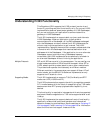
Managing Calls Using IP Telephony
November 2009 221
The following are valid dial string examples for a SIP channel.
Comments are shown in italics.
sip:Joe Smith<Joe@somewhere.com> SIP endpoint address.
sip:800-555-1212@somewhere.com Endpoint gateway specified.
sip:800-555-1212@myproxy.com Proxy explicitly specified.
Joe Smith<Joe@Somewhere.com> SIP endpoint address.
800-555-1212@Somewhere.com Endpoint gateway specified.
800-555-1212@myproxy.com Proxy explicitly specified.
800-555-1212 Will use default proxy server.
+1 (800) 555-1212 Will use default proxy server.
192.168.1.45 Valid, but not recommended.
Joe@192.168.1.1 Valid, but not recommended.
sip:somewhere.com User part (left side of ‘@') is implied.
sip:joe@somewhere.com:9876 An explicit port specification.
sip:011442871234@somewhere.com;user=phone Specifies that user part is a phone number.
Using prefixed dial strings would have the same effect, as in:
fax –u 0 –s sip/t38://xxxxx@brooktrout.com foo.pkt
Using an alternative URI scheme:
fax -u 0 -s 781-555-1212@cisco-gw.brooktrout.com foo.pkt
¾
initiates the following sequence of events:
1. Call Control processes the URI dial string, sends it to the SIP
protocol stack.
2. SIP stack places the SIP call to the Cisco XXXX Gateway.
3. The Cisco Gateway places the call on the PSTN, sending call
progress information to the SIP stack and then finally connecting
the call.
4. The fax is then sent and the call is torn down.
No SIP proxy or redirect server is required if not configured or
needed for point to point calls.
Again, using prefixed dial strings would have the same effect as in:
fax -u 0 -s sip://781-433-9454@cisco-gw.brooktrout.com
foo.pkt


















